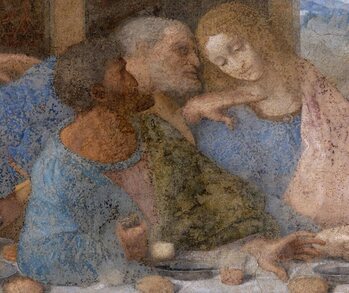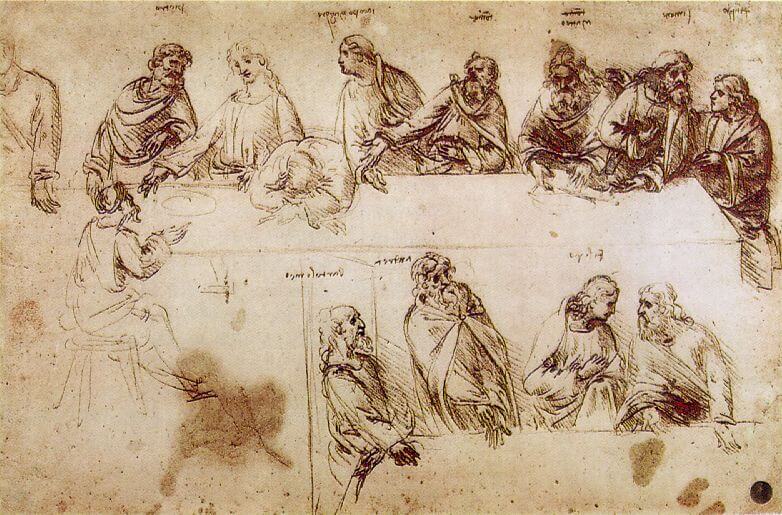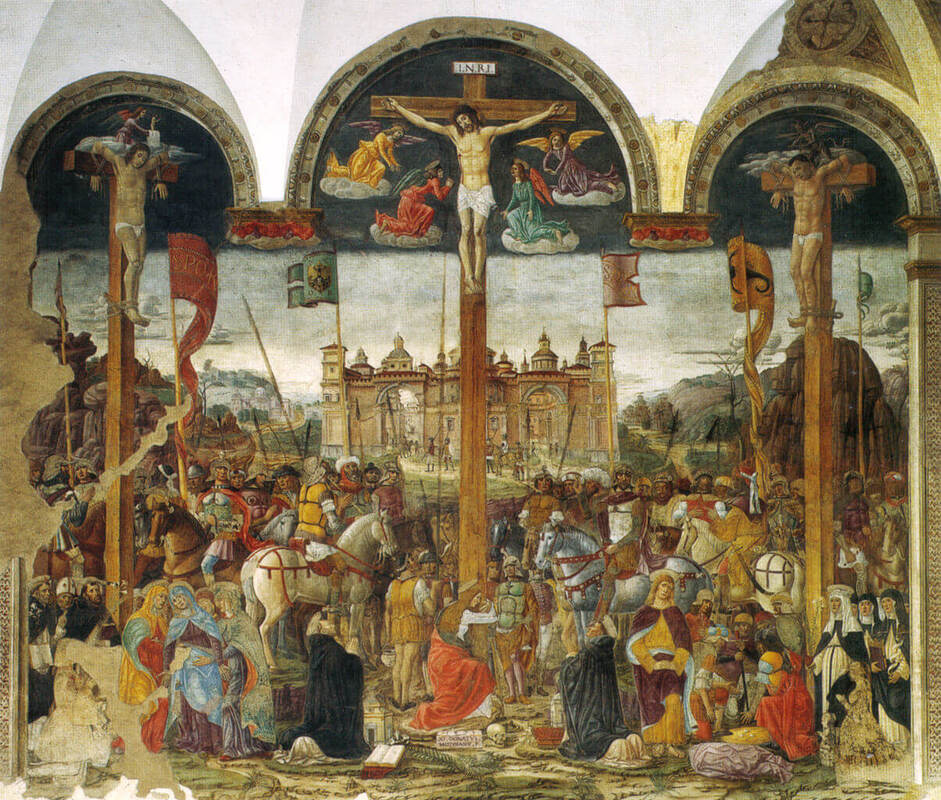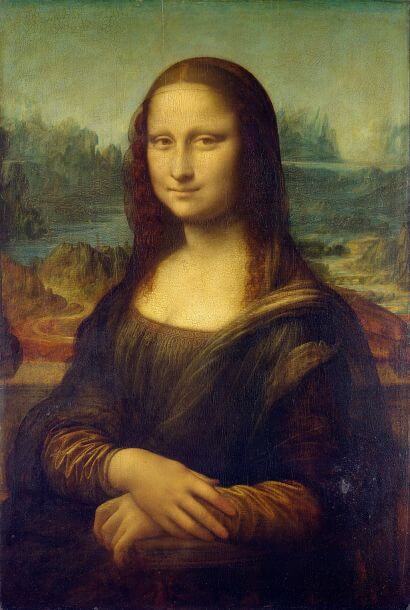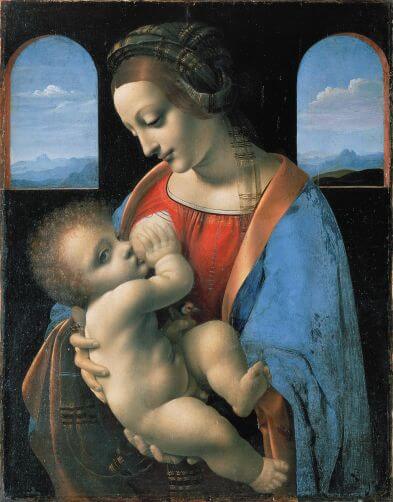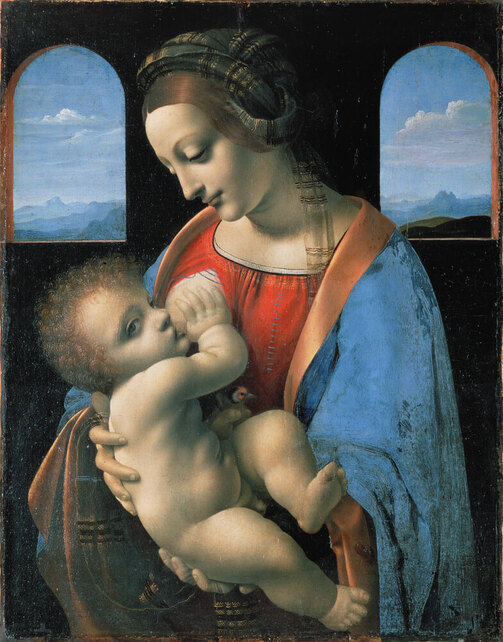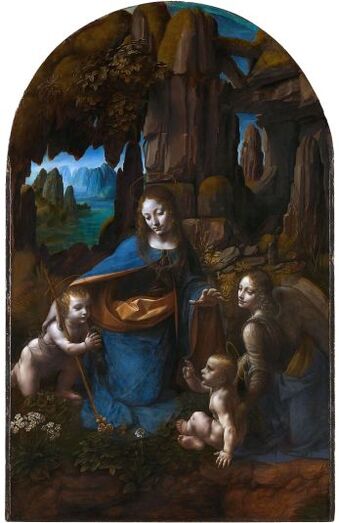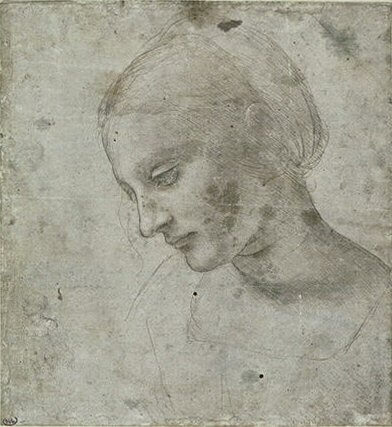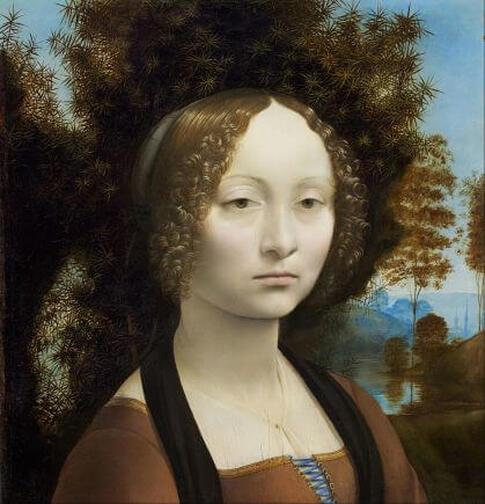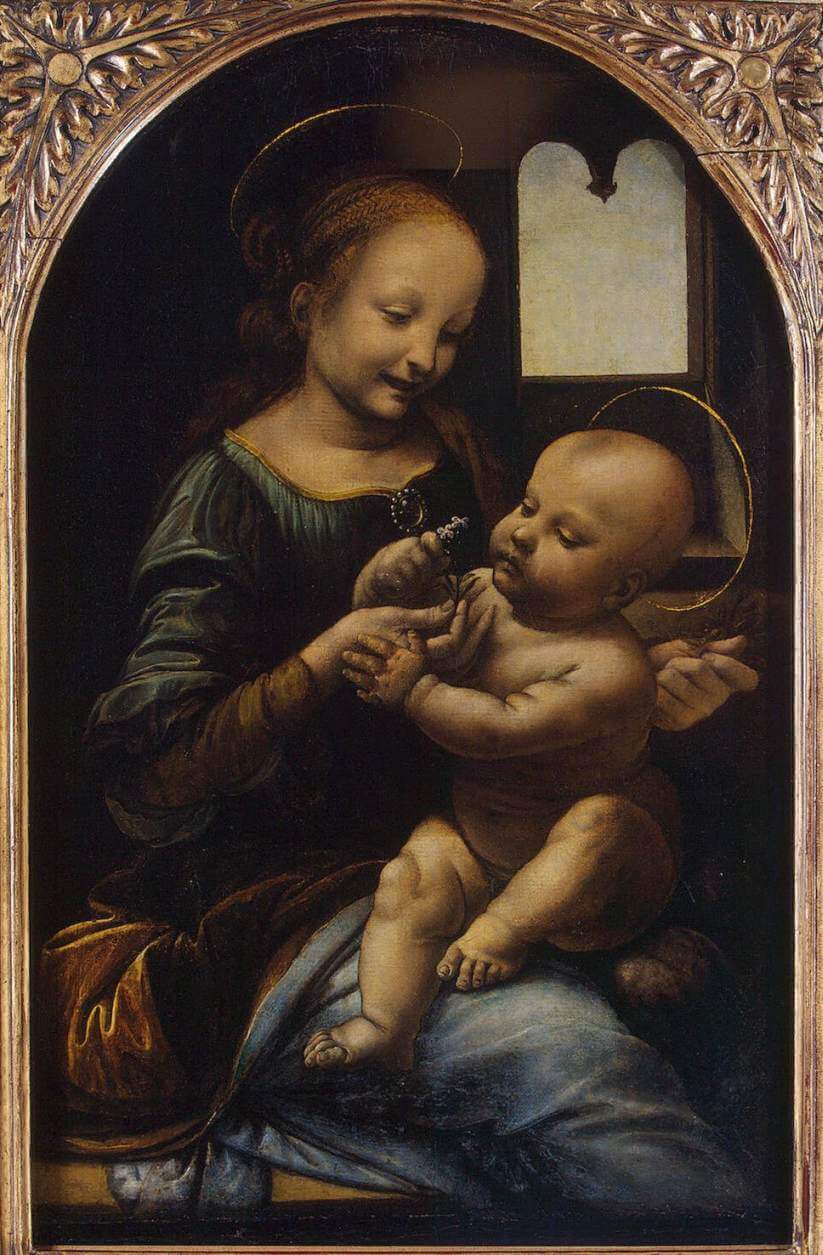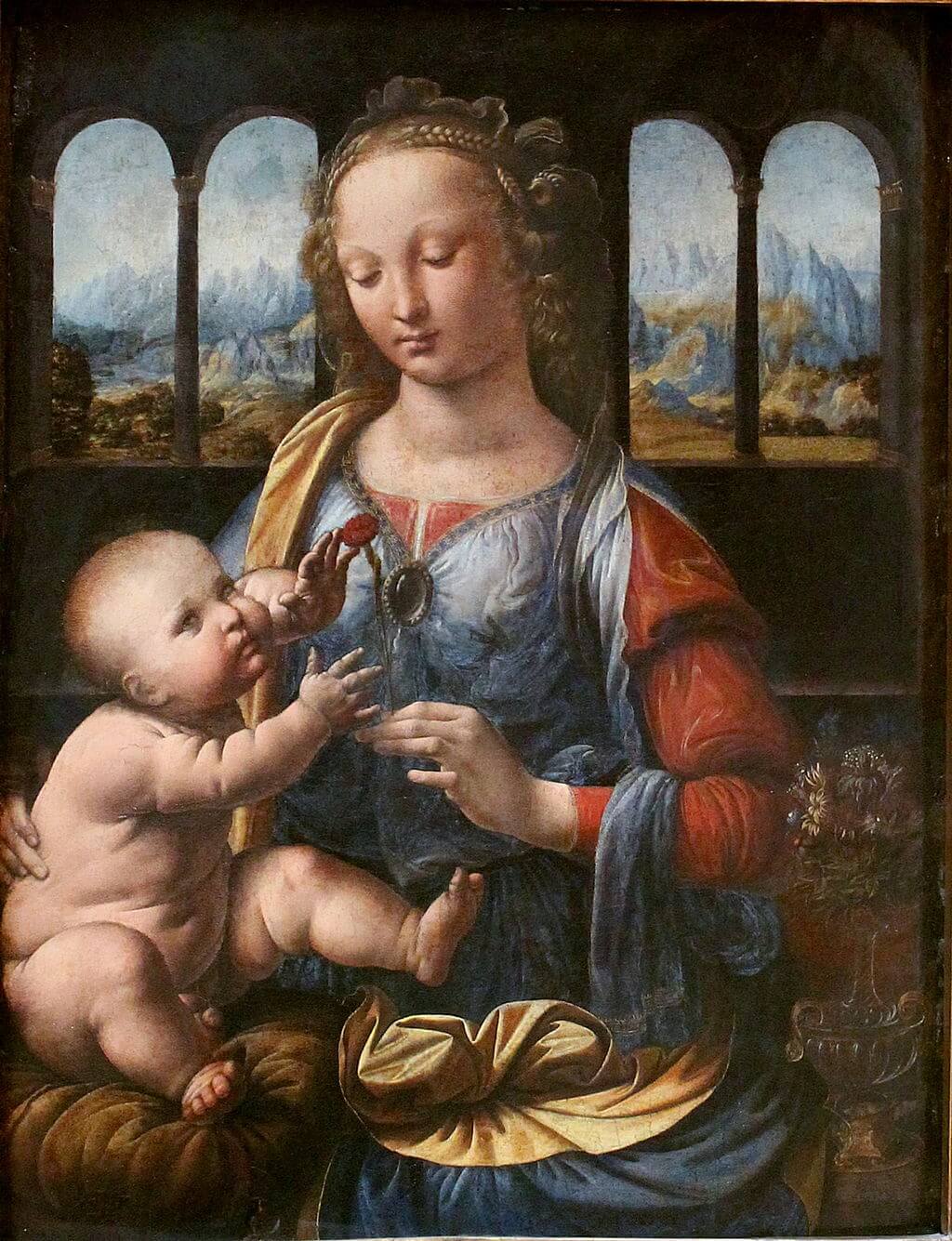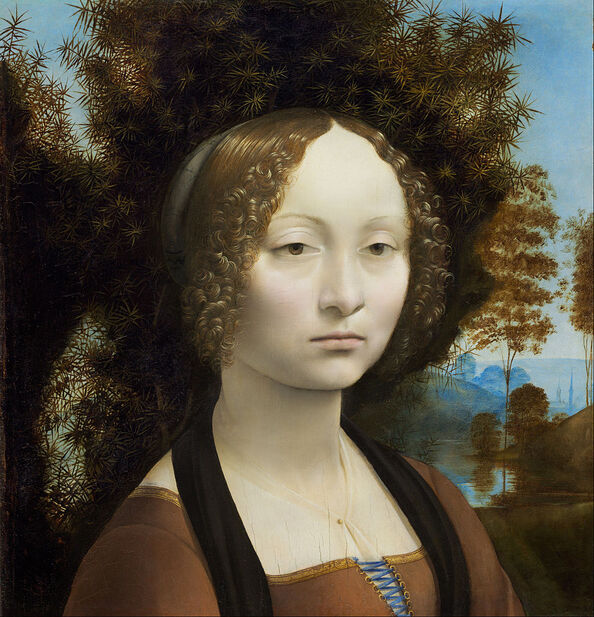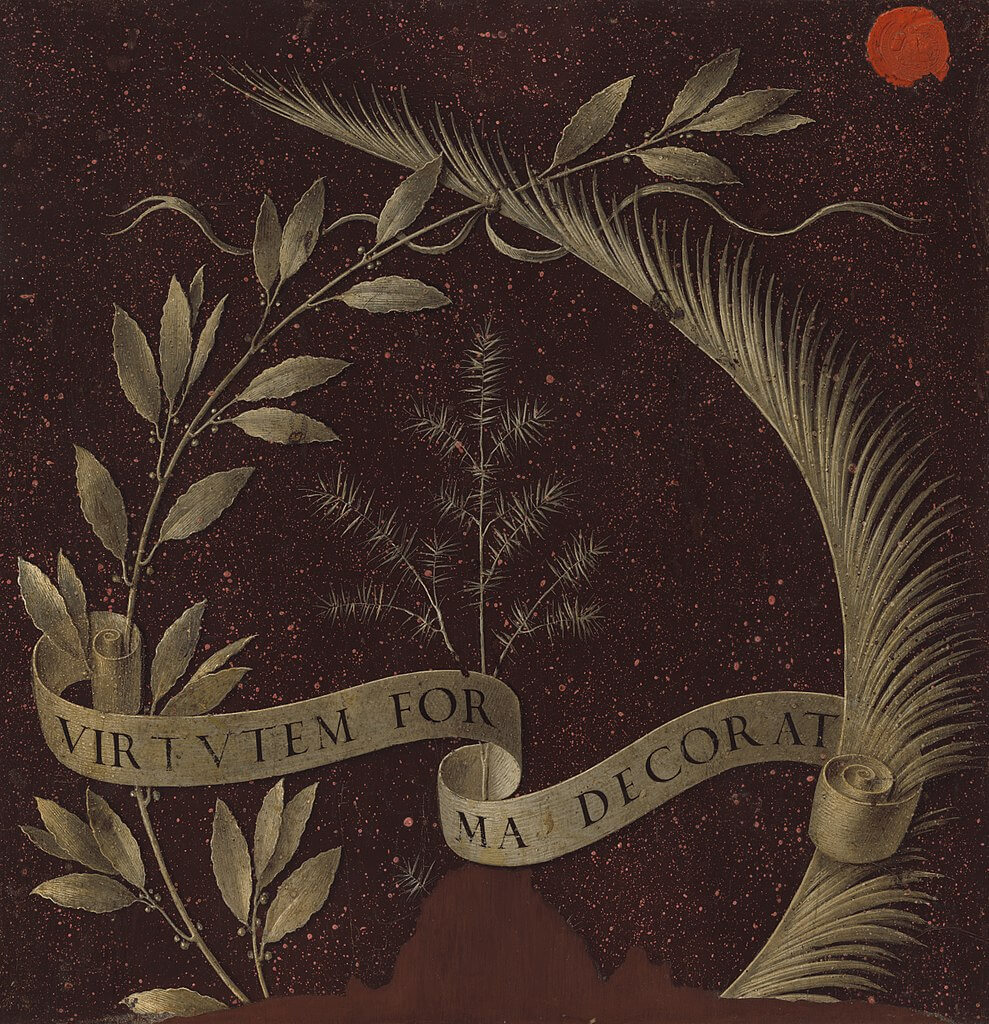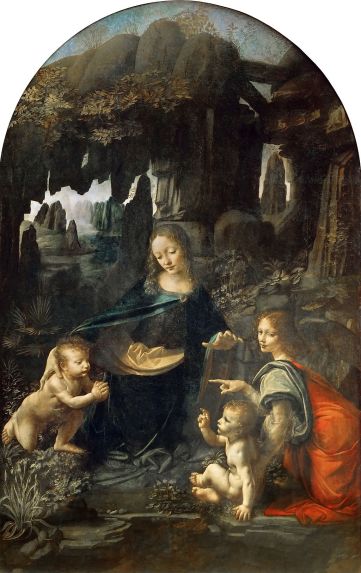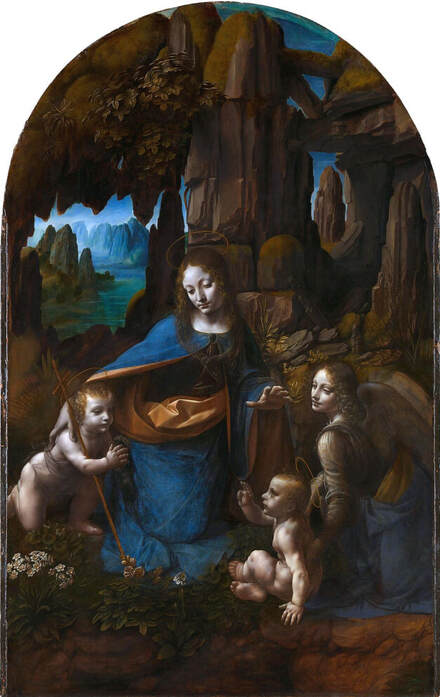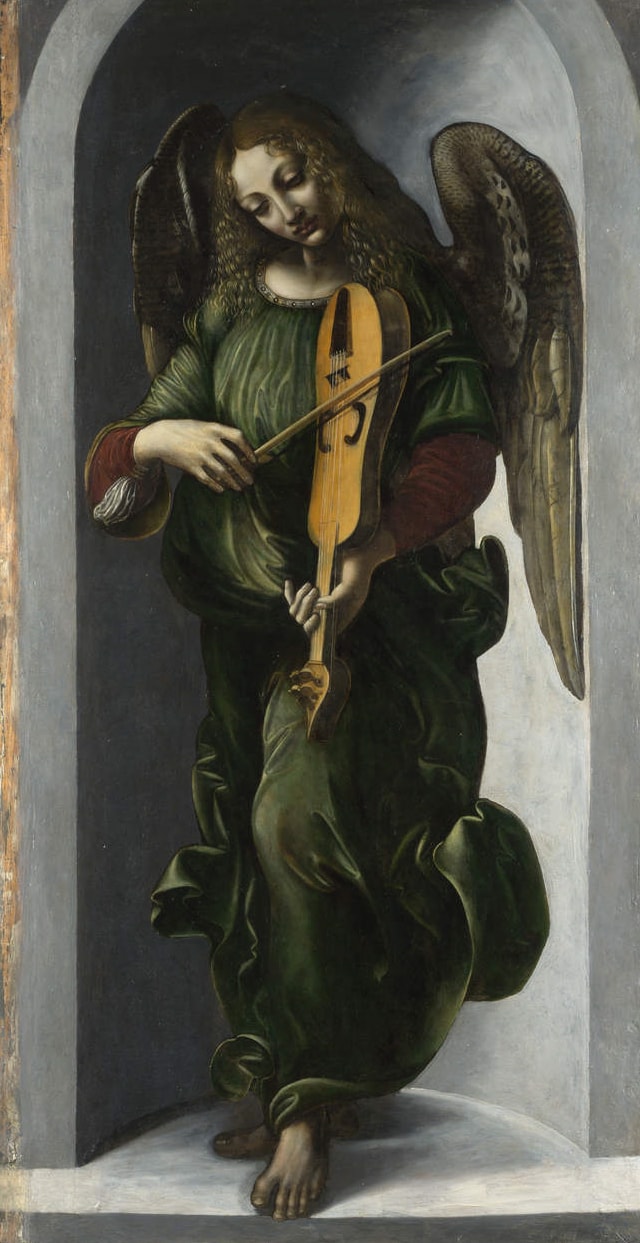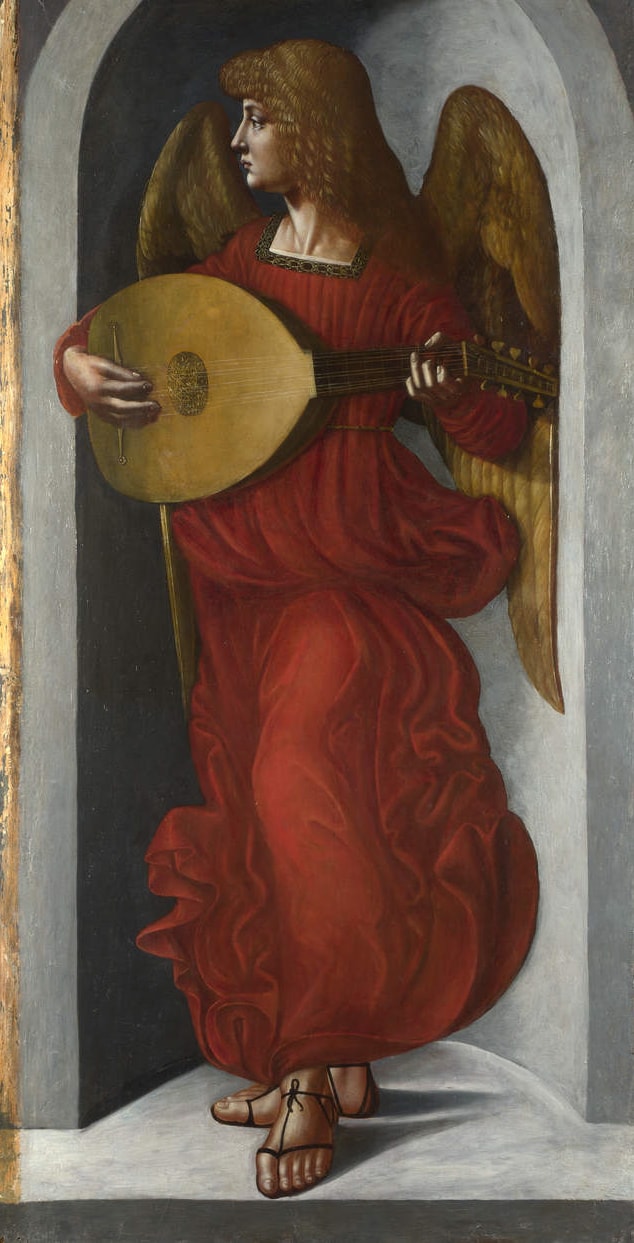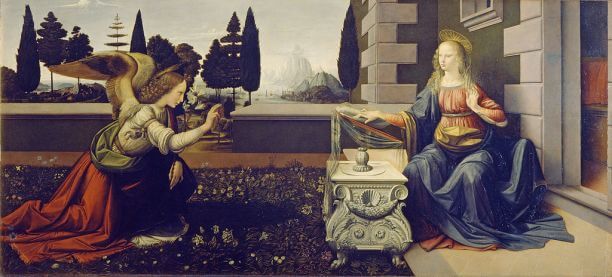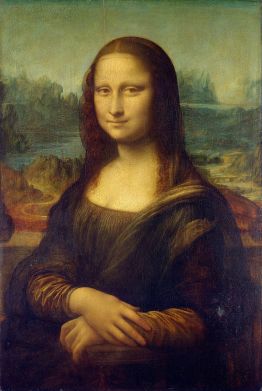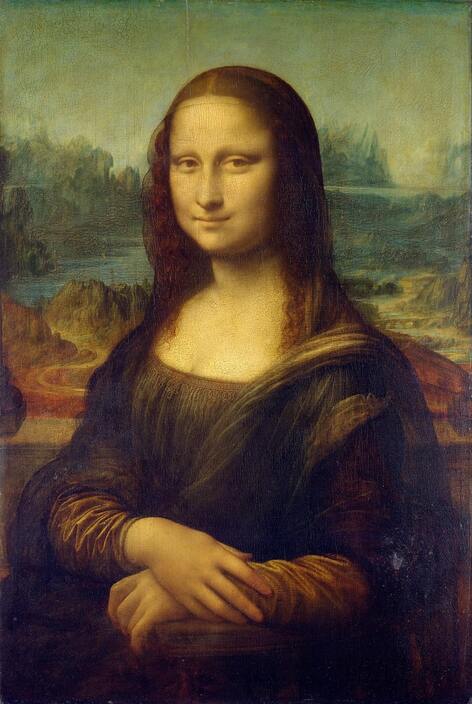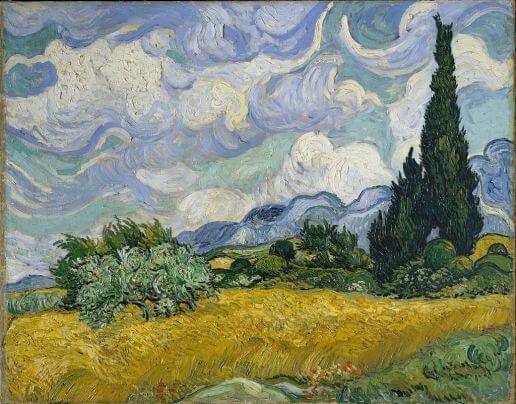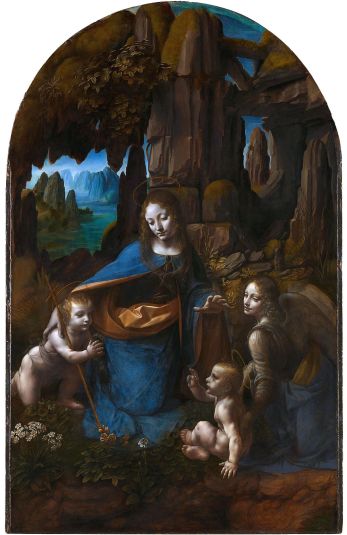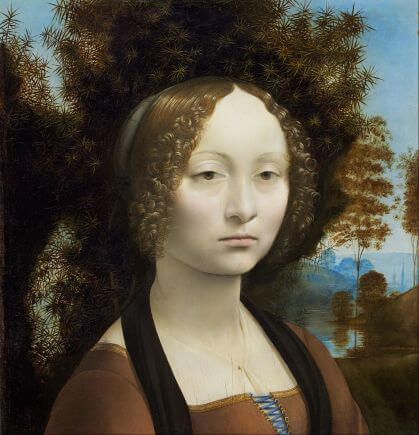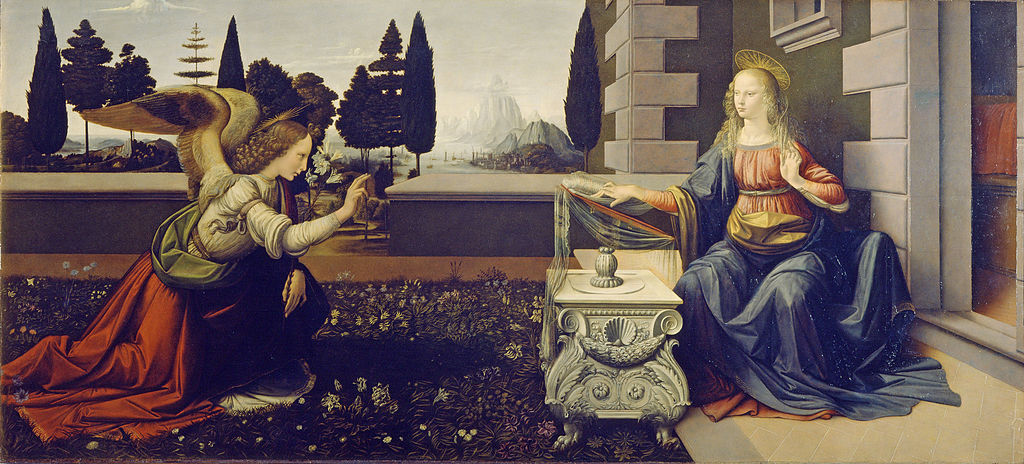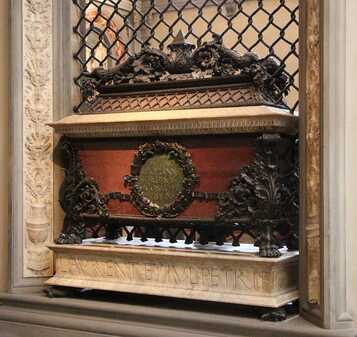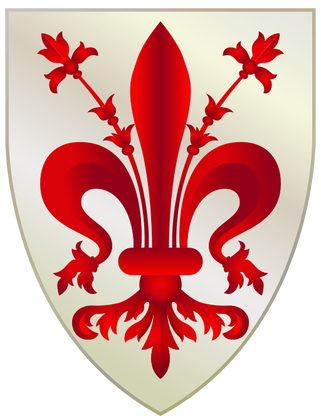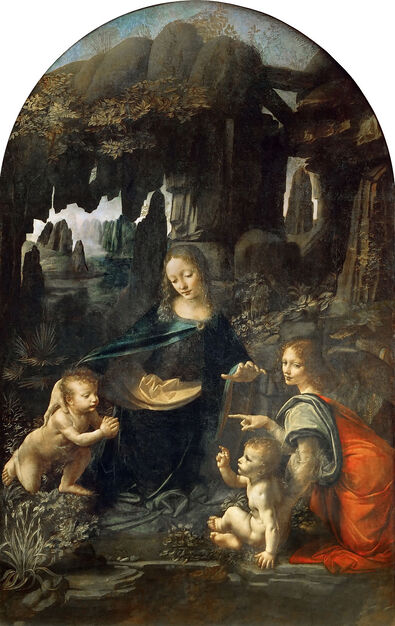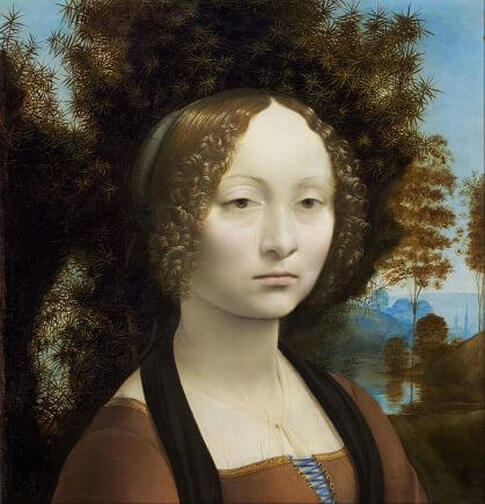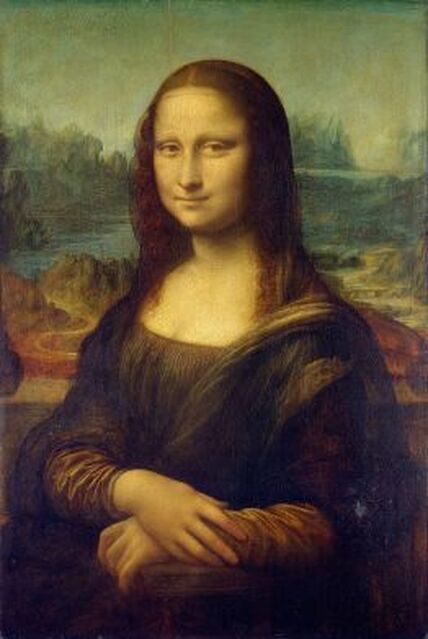|
Where? Santa Maria delle Grazie Dominican Church and Convent in Milan
When? 1495-1498 Commissioned by? Ludovico Maria Sforza, Duke of Milan between 1494 and 1499, for the renovations he had planned for the church and convent. What do you see? The Last Supper where Jesus and the 12 apostles are sharing their final meal before the crucifixion. The fresco is designed so that the space in which the last supper takes place looks like an extension of the architecture of the room itself. In the center is Christ. His outstretched arms touch the table. The 12 apostles are divided, first into two groups of six on each side, and second, into subgroups of three. Each subgroup is a tightly-knit group in composition. Scan the row of heads and see the wave-like arrangement, surging and ebbing.
The ceiling of the room is painted as if coffered, and the coffers provide a clear sense of depth to the mural. In the background are three windows with a view to the landscape. The center window behind Christ, has a semicircular pediment, suggestive of a halo. The right wall is illuminated and the left is in shadow.
Backstory: Leonardo da Vinci always carried a sketch book with him. He looked for facial expressions, bodily movement, and believed the artist had “two principal things to paint, man and the intention of his mind.” He has frozen these 13 men in a moment of time and by doing so, he captured all the drama and excitement of the Gospel verses in The Last Supper. Few sketches remain but below is an early version.
Da Vinci had indicated great concern about painting Christ’s face. Christ is larger than the others (hierarchical perspective) and this is also of theological importance. The spatial isolation of Jesus gives added importance to his image. Da Vinci also used the most expensive paint for Christ—ultramarine.
It is hard to imagine the reactions of the friars and nuns as they entered the refectory to see the mural for the first time (before the mural started to deteriorate). The light, bright, stunning colors of a well-known story told in a brand-new fashion must have been almost shocking. Gone were the traditional halos, the flat facial expressions, the formalism, and instead, a band of 13 young men are seen reacting to an announcement that none of them could believe would happen. The humanism of Da Vinci was a great surprise. In the silence of their shared meals it must have given them much to contemplate. Restoration: Leonardo da Vinci had no experience painting frescos before he started on this mural and used an experimental technique similar to painting on a wooden panel. As a result, the painting is in very poor state as Da Vinci painted on an outside wall with no space to prevent water damage, and he painted with a mixture of oil paint and tempura. The paint did not adhere to the wall and it was decaying even during Da Vinci’s lifetime. Numerous restoration attempts have been made over the centuries, but they usually caused further problems. In 1979, a small group of Italian art restorers began a huge project to properly do the job. It took them 20 years to complete. Symbolism: Christ’s simple pose is complex in detail and meaning—he is silent, sad, and submissive. His right hand extends toward Judas, whose hand is near his. Christ’s hand is palm down, accusing Judas. “The hand that betrayeth me is with me on the table.” At the same time, Christ’s right hand refers to the glass of wine, the symbol of his blood used in the Mass, while his left hand extending to the bread refers to the symbol of his body. The triangular pose of Christ is a reference to the Holy Trinity, an emblematic abstraction of his words, “He who has seen me has seen the Father.” The hand with the forefinger pointing straight upward to the right of Christ, belongs to Thomas. His probing finger refers to the physical resurrection of Christ and points to heaven as a harbinger of the physical ascension. Refectory of Santa Maria delle Grazie: The Last Supper measures 460 cm x 880 cm (15 ft x 29 ft) and covers the end wall of the refectory (dining hall) of the monastery. Painting the mural was not easy and a hazardous task as it was placed 15 feet above the floor. The theme of the Last Supper was a traditional one for refectories. The opposite wall of the refectory is covered by the Crucifixion fresco by Giovanni Donato da Montorfano, to which Leonardo da Vinci added figures of the Sforza family in tempura; these figures have deteriorated in much the same way as those in The Last Supper. Da Vinci worked very thoroughly but slowly and Montorfano was finished before him, to the consternation of Duke Sforza who exhorted Da Vinci to finish his project.
Who is Da Vinci? Leonardo da Vinci was born April 15, 1452 near Vinci in Tuscany. He was the illegitimate son of a 25 year old aspiring lawyer/notary, who had come home for the summer and met the young peasant girl Caterina. He was already engaged to be married but these occurrences were not particularly remarkable at that time.
His paternal grandfather took custody of Leonardo after the birth. The fact that Leonardo was not a legitimate son may have been quite fortunate, as the first legitimate son would have had to follow in his father’s footsteps and become a lawyer. His grandfather allowed him free reign to pursue other interests. When Leonardo was 15 years old, he was sent to Florence to work as an apprentice to Andrea del Verrocchio. He excelled and by the time he was 25, he had his own studio with students. He applied to the Duke of Milan and moved there when he was 30. In 1499, following the Duke’s fall from power, he left Milan and spent a short time in Venice. He returned to Florence in 1500 and in 1516 he moved to France at the invitation of King Francis I. He died there in 1519 at age 67. Among his most famous works are the Mona Lisa in the Louvre and the Madonna Litta in the Hermitage Museum.
Fun fact: The rules of perspective that were used, bring about an unusual effect. This is especially true when looking at the table. The top of the table is always visible, no matter the angle at which you look at the painting. The nuns and friars in the refectory would be sitting well below the mural and it was important that they could see the bread and wine in this fresco.
Another interesting aspect of the fresco is the bottom center of the mural, where a doorway has been cut into the painting. In 1652, the kitchens were relocated to the room behind the refectory and they wanted easier access to the room. They cut out a good portion of the painting, included the feet of Jesus. Fortunately, in 1520, Giampietrino had made a copy of the original in oil on canvas. We can see Jesus’ feet and also the salt cellar spilled by Judas that is no longer visible in the original fresco by Da Vinci. This copy by Giampietrino was very important for the restoration of The Last Supper between 1979 and 1999.
1 Comment
Backstory: This painting is called the Madonna Litta because of a previous owner of the painting, the art collector, count Antonio Litta, from Milan, Italy. Tsar Alexander II acquired this painting in 1865 for the Hermitage Museum.
It is not known when Leonardo da Vinci made this painting exactly as he liked to do multiple projects at once and he often took a long time to complete a painting. What is known is that, in 1479, he already completed the first sketch of a nursing Madonna (now in the Royal Library at Windsor, England). After that, he completed more preparatory works for this painting, including a sketch of the face of Mary which is now in the Louvre. It is assumed that Leonardo started this painting in 1481 and that he stopped working on it for a while because of other commissions.
Symbolism: The scene of the Virgin Mary breastfeeding Baby Jesus shows motherhood and motherly love. The blue mantle of Mary symbolizes the Church and her red dress is a symbol of the passion of Christ. The goldfinch is a symbol of the future crucifixion of Jesus. The mountain landscape in the background represents the greatness of the Creation of the world by God.
What is Madonna Lactans? The Virgin Mary breastfeeding Baby Jesus is the perfect example of motherly love. This theme is referred to as Madonna Lactans or Nursing Madonna. Madonna Lactans has been the subject of quite some paintings from the 12th century until the middle of the 16th century when the Council of Trent discouraged the use of nudity in religious paintings. Madonna Lactans was also a frequent theme in the Orthodox Art in Russia, and this theme is better known as Mlekopitatelnitsa. This may explain why the Russian Tsar Alexander II bought this painting for the Hermitage Museum. Who is Leonardo da Vinci? Leonardo di ser Piero da Vinci (1452-1519) was an expert in a large number of different fields, including astronomy, geology, mathematics, music, and painting. He was born in Vinci, near Florence, and received his artistic education in the workshop of Andrea del Verrocchio. During that time, he already created Ginevra de’ Benci, which is in the National Gallery of Art in Washington, DC. After he finished his apprenticeship with Verrocchio in 1478, he moved to Florence, and in 1482 he moved to Milan where he stayed until 1499. There he worked on many different projects, and he often moved on to the next project leaving the previous one unfinished. Over the next decade, he lived in several different places in Italy. During this time, he created his famous Mona Lisa.
Fun fact: There is a lot of debate whether this painting should be attributed to Leonardo da Vinci or one of his assistants. In 1482, Leonardo mentioned that he had completed one Madonna (probably the Benois Madonna, which is also in the Hermitage Museum) and had almost finished another one. This other Madonna can either be the Madonna Litta or the Madonna of the Carnation, which is in the Alte Pinakothek in Munich.
The main reason that people doubt whether this painting is entirely created by Leonardo is the plain landscape, the somewhat dull outfit of Mary, the shadows in this painting, and the lack of details in her face (compare this to Leonardo’s drawing in the Louvre above). People argue that these aspects are not of the quality that we could expect from Leonardo. However, experts agree that the design of the painting and especially the complicated pose of Mary and Baby Jesus could well be from Leonardo. So, it is not unlikely that Leonardo has started this painting, but that an assistant, maybe Giovanni Antonio Boltraffio, finished the painting. Interested in a copy for yourself? Poster.
Where? Gallery 6 of the National Gallery of Art
When? 1474 Commissioned for? Most likely, either the engagement or marriage of Ginevra de’ Benci. What do you see? The 16- or 17-year old Ginevra de Benci is painted. She is wearing a brown dress with blue laces and gold edges, and a black scarf. Below the dress she wears a subtle white blouse with a golden pin. She has a porcelain-like skin and her hair is styled in ringlets. Her expression is, one the one hand, a bit grumpy, and on the other hand, she seems proud. Her eyes emphasize this. Her left eye (for the viewer) is looking at the viewer, but her right eye seems to be looking down on something. Experts have interpreted the facial expression of Ginevra as an indication that she is not happy with the (upcoming) marriage. Note that Ginevra has only light eyebrows. Shaving the eyebrows was common at that time for women and can also be seen in the Mona Lisa by Leonardo da Vinci. Behind Ginevra is a juniper bush. The halo of spikes from the juniper leaves contrast nicely with the depiction of Ginevra. In the right background are the mountains, trees, water, a small town, and the hazy sky, which are typical for Leonardo da Vinci’s style.
Back of the painting: On the back of this painting is another painting from Leonardo da Vinci, called Wreath of Laurel, Palm, and Juniper. It shows a juniper sprig, with a circular arrangement of palm and laurel around it. It also includes the inscription “Virtutem Forma Decorat”, which means “beauty adorns virtue.”
Backstory: This painting was created to commemorate Ginevra de’ Benci’s engagement or marriage to Luigi di Bernardo Niccolini. Sources have shown that the wedding between both of them took place on January 15, 1474. Bernardo Niccolini was twice the age of Ginevra. During the Renaissance, women were typically only depicted when they got engaged or married.
This is the first known portrait that Leonardo da Vinci painted and the only painting of him in the Americas that is available for public viewing. It was bought in 1967 for $5 million. Symbolism: The juniper bush represents chastity, which was considered to be one of the most important moral standard for women in the Renaissance. At the same time, juniper is a reference to Ginevra’s name as juniper translates into Italian as “ginepro”. The laurel and palm on the back of the painting symbolize, respectively, the intelligence and moral values of Ginepra. However, the laurel and palm were also the personal emblem of Bernardo Bembo, who was thought to have a platonic affair with Ginevra. Bernardo Bembo was the Venetian ambassador to Florence, and he probably commissioned the back of this painting (and according to some also the front of the painting, but this is not proven). Who is Ginevra de’ Benci? Ginevra de’ Benci (born in 1457 or 1458) was the daughter of a wealthy Florentine banker. She was considered to be one of the most intellectual people of her time and was a poet. Later in her life, Ginevra was exiled at her own request because of an unknown illness and tragic love affair. Who is Leonardo da Vinci? Leonardo da Vinci (1452-1519) was born in the Italian village of Anchiano, which was very close to Vinci, which is where he got his name from. He was an architect, astronomer, engineer, inventor, mathematician, musician, painter, writer, and much more. Leonardo da Vinci is known to be one of the biggest multi-talented people that the world has ever seen. He created this painting while he was still a student of Andrea del Verrocchio. Other well-known paintings by Leonardo da Vinci include his Madonna Litta in the Hermitage Museum and Virgin of the Rocks in the Louvre.
Fun fact: About one-third of this painting is missing. At some point in history, someone cut off the lower third of the painting, probably because it was damaged. Based on a drawing of Leonardo da Vinci, it is believed that the part that is cut off probably shows Ginevra folding or crossing her hands in her lap. It is a pity that this part is missing as Leonardo was a specialist in drawing hands. With his diverse interests, he was obsessed by the anatomical correctness when he painted parts of the human body. Ginevra was possibly holding a flower in her hand to symbolize devotion.
Interested in a copy for yourself? Poster or canvas of Ginevra de' Benci; poster of Wreath of Laurel, Palm, and Juniper.
Where? Room 66 of the National Gallery
When? 1495-1508 Commissioned by? Prior Bartolomeo Scorlione and the Confraternity for the Chapel of the Confraternity of the Immaculate Conception in the church of San Francesco Maggiore in Milan. What do you see? The Virgin Mary, the children Jesus and John the Baptist, and an angel are pictured in a triangular composition in a rocky environment. The Virgin Mary is sitting on the ground, which is referred to as the Madonna of Humility. She is the center of attention in this painting. The right hand of Mary is on the shoulder of John the Baptist (who is the child on the left). The left hand of Mary is right above the head of Jesus, which can be interpreted as a protective gesture. John the Baptist is folding his hands and is praying towards Jesus. At the same time, Jesus, who is directly to the left of the angel, is raising his right hand to bless John the Baptist. The angel most likely represents the Archangel Gabriel, even though the angel looks quite feminine (the painting of androgynous figures was a trademark of Leonardo da Vinci). In the background you can see the rocky grotto and a river, most likely inspired by the Dolomite Mountains, which are to the northeast of Milan. In the foreground and the grotto, various flowers and plants are depicted (including irises, lilies, and ivy). Backstory: The commissioner of this painting wanted Leonardo da Vinci to paint the Immaculate Conception (a Catholic dogma that Mary was born without sin) to serve as the center of an altarpiece for the Chapel of the Immaculate Conception. This chapel is part of the Saint Francesco Grande church in Milan, and the chapel has been founded before 1335 by Beatrice d’Este, who was the wife of Galeazzo I, the Duke of Milan. On the left and right of this painting would be two paintings of angels playing a musical instrument to complete the altarpiece. On the left is An Angel in Green with a Vielle painted by an associate of Leonardo, possibly Francesco Napoletano. On the right is An Angel in Red with a Lute by Giovanni Ambrogio de Predis.
Leonardo da Vinci has painted the biggest part of this work but he has some help from his assistants. One important argument, according to The Guardian, which supports the involvement of some assistants is that some of the flowers and rocks are not accurately depicted (whereas one of the trademarks of Leonardo is that he was always very accurate in depicting natural elements in his work).
Symbolism: The rocks and caves represent sanctuary. The rocks also refer to Jesus, who is often called the rock of the Christian religion. The flowers and plants are also carefully chosen. For example, the palm leaves, which can be seen behind the head of John the Baptist, are a symbol of Mary and a symbol of Jesus victory over earthly temptations. The angel is clearly identified based on his wings. Mary is directly visible by her blue clothing and the halos help us to identify who is sacred/holy. John the Baptist can easily be identified by his cross of martyrdom. Who is Leonardo da Vinci? Leonardo da Vinci (1452-1519) was born in the Italian village of Anchiano, which was very close to Vinci, which is where he got his name from. He was an architect, astronomer, engineer, inventor, mathematician, musician, painter, writer, and much more. Leonardo da Vinci is known to be one of the biggest multi-talented people that the world has ever seen. Leonardo was notorious for being substantially late in delivering his paintings and was not afraid to abandon projects halfway. Most of the surviving paintings of Leonardo have become famous, including The Annunciation (in the Uffizi Museum) and the Mona Lisa (in the Louvre).
Fun fact: Interestingly, there are two versions of this famous painting. The other version of The Virgin of the Rocks is in the Louvre.
The version in the Louvre was the first to be completed and is much less conventional. For example, the current version in the National Gallery contains halos on top of the heads of John the Baptist, Jesus, and Mary, and John the Baptist is carrying a cross with him (these elements are not present in the version in the Louvre). You can also see a clear difference in the face of Jesus. Also, in the National Gallery version of the painting, the angel is not pointing at John the Baptist and seems to gaze in the distance (as if the angel is dreaming/imagining this scene, instead of participating in it). The reason that there are two versions of this painting is that the Confraternity rejected the first version of Leonardo. It was not traditional enough (for example, no halos and a lack of symbolism) and thus did not suit the purpose of representing the dogma of the Immaculate Conception (which was the sole purpose of the Confraternity). Leonardo da Vinci considered the Louvre version of the painting a real masterpiece in which he could perfectly express his artistic ideas. After the Louvre version of the painting was rejected, Leonardo created another version of this painting (the current version), which included all elements that the Confraternity asked for. Interested in a Copy for Yourself? Poster
Where? First floor, room 711 of the Denon wing in the Louvre
When? Between 1503 and 1517 Commissioned by? Francesco del Giocondo, the husband of Mona Lisa. What do you see? A half-body portrait of Lisa del Giocondo. She is sitting outside in a chair with a straight posture. Her curly hair hangs on her shoulders, and she has a transparent veil on her head (which may be a sign that she is pregnant). She is wearing a dress with a bit of lace and a scarf over the shoulders. The light skin of her contrasts nicely with the darker tones in the rest of the painting. Note that she has no eyebrows, something that was not uncommon in portraits from that time, though research has shown that the Mona Lisa may originally have had some faint eyebrows. Her hands are crossed and laying on an armrest. She looks at us with an ambiguous expression. Her eyes and her small mysterious smile have been intriguing to viewers all across the world. What is she thinking about and what is she looking at? The background shows a rocky landscape, and Leonardo da Vinci was the first to include such a background in a portrait painting. You can see almost snowy mountains, a winding road on the left and a bridge on the right. It seems that the landscape on the left and the right of Mona Lisa do not match up as the left side is lower than the right side. Backstory: Mona Lisa means ‘my lady Lisa. The word ‘mona’ is a short version of Madonna, which means ‘my lady’. This painting is also known in Italian as La Gioconda named after her last name. This painting was a very innovative one in the time that it was painted due to its composition and the painting technique used by Leonardo da Vinci. Da Vinci accepted the commission for this painting during a time in which he had little money. However, soon after he received some big commissions and it took him, therefore, many years to complete this painting. After Leonardo da Vinci started to work in France, this painting was acquired by King Francis I of France. So, Da Vinci never delivered this painting to its commissioner. The painting remained in France ever since and Napoleon Bonaparte put the painting in his bedroom. In 1804, the painting was moved to Louvre and people could now see the painting that Napoleon was sleeping with. The painting is nowadays displayed in a climate-controlled room and behind bullet-proof glass. Sfumato? One of the things that makes this painting so popular is the use of sfumato by Leonardo da Vinci. This is a technique that Da Vinci developed in which he blended colors on the canvas. Sfumato is derived from the Italian word ‘fumo’, which means smoky. When we translate sfumato to English, it means something like soft or blurry. The transitions from light to dark are barely visible on the canvas, and you cannot see the brushstrokes on the painting. The soft transition is in stark contrast to the impressionist paintings, where the brush strokes are very visible. For example, look at Wheat Field with Cypresses by Van Gogh. The use of the sfumato technique leads to more realistic paintings. Other good examples of the sfumato technique are Da Vinci’s paintings of the Virgin of the Rocks of which one version is in the Louvre and another one in the National Gallery of Art. The sfumato technique had a big influence on other artists, including Raphael, who adopted this technique for some of his portraits.
Who is Mona Lisa? Born as Lisa di Antonio Maria Gherardini in the Republic of Florence in 1479, Lisa married with Francesco di Bartolomeo di Zanobi del Giocondo in 1495. She was the third wife of Francesco, who was a merchant and later became a government official in Florence. It seems that their marriage was based on real love, which was not that common during that time, and together they got five children.
Francesco came from a family of art lovers and commissioned a painting of Lisa to celebrate the purchase of a new home. Mona Lisa lived a normal life and apart from this painting not much is known about her. Who is Leonardo da Vinci? Leonardo di ser Piero da Vinci (1452-1519) was born in Vinci in the Republic of Florence. He is considered to be the ultimate Renaissance man as he was not only an artist, but also an astronomer, a geologist, an inventor, a mathematician, a musician, and a writer. Together with Donatello, Michelangelo, and Raphael, he is considered to be one of the four leading artists from the Renaissance. He created a large variety of art, but he often did not finish his works. Among his surviving works are a few portraits including his Ginevra de’ Benci in the National Gallery of Art.
Fun fact: In August of 1911, the Mona Lisa was stolen from the Louvre. This theft was a big shock as the Louvre was heavily guarded and it was a big mystery how the painting got stolen. However, it was not a complete disaster as, in 1911, the Mona Lisa was not yet considered to be the best painting in the world yet. The robbery spurred a lot of attention for the painting in the media.
One of the popular theories from those days was that Picasso stole the painting. The police even questioned Picasso but found no evidence against him. In 1913, the painting was retrieved when an employee of the Louvre wanted to sell the painting for $100,000 to the Uffizi Museum in Florence. After this robbery, the Mona Lisa was suddenly one of the most special paintings in the world, and it has only grown in popularity since. Nowadays, about ten million people visit the Louvre each year, and most of them want to see this painting. Interested in a copy for yourself? Poster of canvas (Amazon links).
Where? Room 35 of the Uffizi Museum
When? 1472-1475 Commissioned by? Unknown What do you see? Mary sits on a paved terrace in front of a palace-like building and is reading at a richly decorated desk carved from marble. She gets surprised by a visit of the youthful Archangel Gabriel, who explains to her that she will be the mother of the Son of God. Gabriel raises his right hand to greet Mary and holds a white lily in his left hand. Mary hesitantly raises her left hand to greet the angel. The landscape in the back shows mountains, a sea, and cypresses, all typical elements present in the paintings of Leonardo da Vinci. All perspectives – height, width, and depth – converge on Mary, making her the center of attention. Interestingly, the desk of Mary and the palace-like building seem somewhat out of place in this setting, and the figures of Mary (who is usually described as a simple woman) and Gabriel seem to fit better with the bed of flowers and the nature-like background. Backstory: This painting has been in the Uffizi since 1867. Before that it hung in the San Bartolomeo at Monte Oliveta Church in the countryside of Tuscany. There has been a constant debate on who painted this work. The consensus is now that this painting was created in the workshop of Andrea del Verrocchio. A popular explanation is that the painting was started by Andrea del Verrocchio, who left a note to his pupil Leonardo da Vinci to finish the painting. This painting is now considered by many to be Leonardo’s first major work, as he made the background, the wings of the angel, and the finishing touches to the painting. The painting is based on Luke 1: 26-38, where the Archangel Gabriel foretells the birth of Jesus to Mary. Symbolism: The angel holds a Madonna lily in his left hand. This lily represents the purity of Mary and is also the symbol of the city of Florence. Mary can be identified by her dress which is largely blue. The enclosed garden in which Gabriel is kneeling is a symbol of Mary’s virginity. The marble desk or sarcophagus in the middle has been painted after the tomb of Piero and Giovanni de’ Medici which was carved by Verrocchio.
Who is Mary? The Virgin Mary has been the most popular subject in Christian art. She represents four Roman Catholic dogmas, which are at the basis of Catholicism: Perpetual Virginity (when she gave birth to Jesus), Mother of God, Immaculate Conception (Mary was already without sins in the womb of her mother), and the Assumption into Heaven at the end of her life.
Why the Annunciation? The ‘Annunciation’ has already been the subject of art since the fourth century. It has been a very popular theme in Florentine art. It shows the moment that the Archangel Gabriel tells the Virgin Mary that she will give birth to the Son of God. Who is Leonardo da Vinci? Leonardo da Vinci (1452-1519) was an architect, astronomer, engineer, inventor, mathematician, musician, painter, writer, and much more. He is known to be one of the biggest multi-talents the world has ever seen. The fact that he studied science and nature extensively helped him in his artwork. He has produced a large number of sketches in which he practiced to draw specific human features, such as hand gestures, facial expressions, bone structures, and other anatomical features. Some of his most famous paintings include the Mona Lisa in the Louvre and the Virgin of the Rocks of which one version is in the Louvre and another version in the National Gallery in London.
Fun facts: The wings of the Archangel Gabriel are painted by Leonardo da Vinci and are most likely copied from a bird in flight. However, if you look carefully, these wings have been extended later on by another unknown artist.
People have also noticed some rookie mistakes in this painting, indicating that the young Leonardo was still mastering the tricks of perspective. For example, look at the right hand of Mary, which rests on the reading desk. The desk is closer to the viewer than Mary. However, that makes it strange that Mary’s right hand is on the left side of the reading desk. In other words, her right hand is too close to the viewer compared to the rest of her body. Finally, the painting lacks some of the emotions in the faces of the angel and Mary. But Da Vinci would learn over time how to include these emotions, which is clearly visible in his Mona Lisa. Interested in a copy for yourself? Poster
Where? First floor, room 710 of the Denon wing in the Louvre
When? 1483-1486 Commissioned by? Prior Bartolomeo Scorlione and the Confraternity for the Chapel of the Confraternity of the Immaculate Conception in the church of San Francesco Maggiore in Milan. What do you see? The Virgin Mary, the children Jesus and John the Baptist, and an angel are pictured in a triangular composition in a rocky environment. The Virgin Mary sits on the ground, which is referred to as the Madonna of Humility. She is the center of attention in this painting. The right hand of Mary is on the shoulder of John the Baptist (who is the child on the left). The left hand of Mary is right above the head of Jesus, which can be interpreted as a protective gesture. John the Baptist is folding his hands and is praying towards Jesus. At the same time, Jesus, who is directly to the left of the angel, is raising his right hand to bless John the Baptist. The angel most likely represents the Archangel Gabriel, even though the angel looks quite feminine (the painting of androgynous figures was a trademark of Leonardo da Vinci). The angel is pointing towards John the Baptist. In the background you can see the rocky grotto and a river, most likely inspired by the Dolomite Mountains, which are to the northeast of Milan. In the foreground and in the grotto various flowers and plants are depicted (including irises, lilies, and ivy). The painting has been finished using the sfumato technique, the smoky/hazy effects, which creates a somewhat magical atmosphere. Backstory: The commissioner of this painting wanted Leonardo da Vinci to paint the Immaculate Conception (a Catholic dogma that Mary was born without sin) to serve as the center of an altarpiece for the Chapel of the Immaculate Conception. This chapel is part of the Saint Francesco Grande church in Milan, and the chapel was founded before 1335 by Beatrice d’Este, who was the wife of Galleazzo I, the Duke of Milan. On the left and right of this painting would be two paintings of angels playing a musical instrument to complete the altarpiece. On the left is An Angel in Green with a Vielle painted by an associate of Leonardo, possibly Francesco Napoletano. On the right is An Angel in Red with a Lute by Giovanni Ambrogio de Predis. The Virgin of the Rocks in the Louvre is thought to be painted entirely by Leonardo da Vinci, which is not always the case for paintings of Leonardo.
Symbolism: This work contains several symbolic references:
This painting is also one of the first known paintings in which the halos are left out. The halos were used in the Middle Ages to indicate that somebody was holy or sacred but were in contrast to the realistic painting style of the Renaissance. What is sfumato? Sfumato comes from the Italian sfumare, which means ‘to evaporate like smoke’ and Leonardo da Vinci famously used the sfumato technique to create the atmosphere in his paintings. Leonardo applied the sfumato technique when the painting was almost finished by applying a coat of a mix of varnish and black pigment to create a hazy/smoky effect. Who is Leonardo da Vinci? Leonardo da Vinci (1452-1519) was born in the Italian village of Anchiano, which was very close to Vinci, which is where he got his name from. He was an architect, astronomer, engineer, inventor, mathematician, musician, painter, writer, and more. Leonardo da Vinci is known to be one of the biggest multi-talented people that the world has ever seen. Leonardo was notorious for being substantially late in delivering his paintings and was not afraid to abandon projects halfway. Leonardo has created a few famous portraits, including Ginevra de' Benci in the National Gallery of Art and the Mona Lisa in the Louvre.
Fun fact: Interestingly, there are two versions of this famous painting. The other version of The Virgin of the Rocks is in the National Gallery in London. The version in the Louvre was the first to be completed and is much less conventional.
For example, the version in the National Gallery contains halos on top of the heads of John the Baptist, Jesus, and Mary, and John the Baptist is carrying a cross with him (these elements are not present in the version in the Louvre). You can also see a clear difference in the face of Jesus. Also, in the National Gallery version of the painting, the angel is not pointing at John the Baptist and seems to gaze into the distance (as if the angel is dreaming/imagining this scene, instead of participating in it). The reason that there are two versions of this painting is that the Confraternity rejected the first version of Leonardo. It was not traditional enough (for example, no halos and a lack of symbolism) and thus did not suit the purpose of representing the dogma of the Immaculate Conception (which was the sole purpose of the Confraternity). Leonardo da Vinci considered the Louvre version of the painting a real masterpiece in which he could perfectly express his artistic ideas. After the Louvre-version of the painting was rejected, Leonardo created another version of this painting (the version in the National Gallery in London), which included all elements that the Confraternity asked for. Interested in a Copy for Yourself? Poster or canvas. |
Categories
All
|
- Home
- Blog
-
Museums
- Alte Pinakothek
- Art Institute of Chicago
- Baltimore Museum of Art
- Barber Institute of Fine Arts
- Bargello
- Barnes Foundation
- British Museum
- Church of Sant’Anastasia
- Cleveland Museum of Art
- Courtauld Institute of Art
- Detroit Institute of Arts
- Frans Hals Museum
- Galleria Borghese
- Gallerie dell'Accademia
- Getty Museum
- Guggenheim
- Hermitage Museum
- Kunsthistorisches Museum
- Kunstmuseum Basel
- Legion of Honor Museum
- Louvre
- Mauritshuis
- Metropolitan Museum of Art
- Musee d’Orsay
- Museum of Fine Arts in Boston
- Museum of Modern Art
- National Gallery in London
- National Gallery of Art
- National Museum in Poznań
- Norton Simon Museum
- Ny Carlsberg Glyptotek
- Palace of Versailles
- Palazzo Pitti
- Palazzo Vecchio
- Petit Palais
- Philadelphia Museum of Art
- Prado
- Pushkin Museum
- Ravenna Art Museum
- Rijksmuseum
- San Diego Museum of Art
- Santa Maria delle Grazie
- St. Peter's Basilica
- Städel Museum
- Statens Museum for Kunst
- Tate Britain
- Tate Modern
- Timken Museum of Art
- Uffizi
- Vatican Museums
- Wallace Collection
-
Artists
- Altdorfer
- Anguissola
- Berlin Painter
- Bosch
- Botticelli
- Boucher
- Bronzino
- Bruegel the Elder
- Brunelleschi
- Cabanel
- Caillebotte
- Canova
- Caravaggio
- Carpeaux
- Cezanne
- Cimabue
- David
- Degas
- Delacroix
- De Maria
- Donatello
- El Greco
- Fontana
- Fra Angelico
- Fragonard
- Gauguin
- Gentileschi
- Gericault
- Gonzalez-Torres
- Goya
- Hals
- Hogarth
- Hokusai
- Ingres
- Leonardo da Vinci
- Lippi, Filippo
- Longhi, Barbara
- Lorrain
- Makovsky
- Manet
- Massys
- Matisse
- Merian
- Michelangelo
- Mochi
- Modigliani
- Monet
- Panini
- Parmigianino
- Perugino
- Picasso
- Pisanello
- Raphael
- Rembrandt
- Renoir
- Reynolds
- Rivera
- Rodin
- Rubens
- Scultori
- Seurat
- Steen
- Tintoretto
- Titian
- Toulouse-Lautrec
- Turner
- Uccello
- Van der Weyden
- Van Dyck
- Van Eyck
- Van Gogh
- Van Hemessen
- Vasari
- Velazquez
- Vermeer
- Veronese
- Vigée Le Brun
-
Locations
- Books
- About Us


